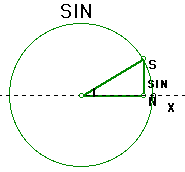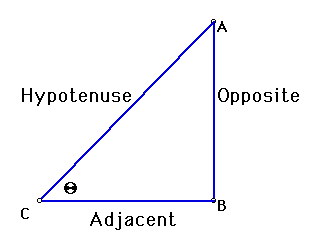To do this part of the lesson,
download this
Geometer's Sketchpad file and open
it.
Recall from the previous section that you found the SIN of an
angle to be the ratio of the OPPOSITE side to the HYPOTENUSE. As you
may have thought there are ratios that can be formed using the other
sides of the triangle. In this section, we will investigate the other
major types of trig ratios.
In the Sketchpad file we have three circles all with radii of
1. Each is called the UNIT CIRCLE. We will use it to investigate the
other trig ratios.
STEP 1: Consider this diagram.

Look at triangle NIS. The HYPOTENUSE is the same as the radius
of the circle. Therefore, it has a measure of 1. Recall the SIN ratio
we discovered in the last section for angle SIX. It is,
SIN (< XIS) = OPPOSITE (SN) / HYPOTENUSE(IS)
Since the HYPOTENUSE = 1, the SIN (angle XIS) = the length of
the OPPOSITE side. That's what makes the UNIT CIRCLE special!
<>
STEP 2:MEASURE <SIX, MEASURE the SIN of
<SIX, <>Now, measure the length of SN?
What do you notice about the measures? Explain why this is so.
STEP 3:Double-click the ANIMATE button under the SIN
circle.
Form a conjecture about the relationship between the side
length (SN) and the SIN of the angle.
For the next steps use the circle under the COS label.
<>
STEP 4:MEASURE <XOC, MEASURE the cosine (COS) of
<XOC, <>Now, measure the length of OS?
What do you notice about the measures?
STEP 5:Double-click the ANIMATE button under the COS
circle.
Form a conjecture about the relationship between the side
length (OS) and the COS of the angle.
STEP 6: Write down the ratio for the COS <XOC
STEP 7: Use the figure below to write down the ratio
for the
COS <BCA

For the next steps use the circle under the TAN label.
<>
STEP
8:MEASURE <TAX, MEASURE the
Tangent (TAN) of
<TAX, <>Now, measure the length of TA, TN, and AN?
Do you notice anything about the measures of the sides and the
TAN <TAX?
CALCULATE the ratio of SIDE (TN) to SIDE (AN)
Now, do you notice anything about the measures of the sides
and the TAN <TAX?
STEP 9:Double-click the ANIMATE button under the TAN
circle.
Form a conjecture about the relationship between the side
lengths (TN) and side (AN) and the TAN of the angle.
STEP 10: Write down the ratio for the TAN <TAX
STEP 11: Use the figure below to write the ratio for
the TAN <BCA



